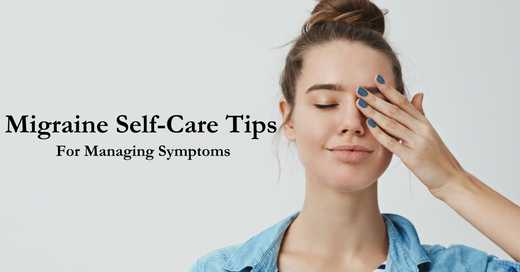
Empowered Relief: Essential Migraine Self-Care Tips for Managing Symptoms
Share
Migraines can be a challenging physical and emotional experience. Creating a calm environment, drinking plenty of water, moving gently, using mindfulness and relaxation techniques, applying cold or warm compresses, sticking to a regular sleep schedule, keeping a food journal, limiting screen time, talking to someone about your migraines, and getting professional help are some self-care strategies you can try to manage them. Remember to be gentle with yourself during this time and take small steps towards self-care to alleviate symptoms and provide comfort
Table of Contents
Migraine Self-Care Tips
Although controlling migraine flare-ups may be challenging due to their unpredictable nature, there are some migraine self-care recommendations that, if followed, can significantly improve your quality of life:
- Being outside in order to get enough vitamin D
- Maintaining a Symptom Diary
- Taking in adequate water
- keeping a regular meal schedule
- Cutting back on caffeine or alcohol consumption
- Ample Sleep
- Accupuncture
- Limiting Screen Time
- Steer clear of bright lights and loud noises.
- Physical Activity
- Hot or cold Therapy
- Breathing Exercises
- Avoiding Dietary Triggers
- Prioritise balancing your energy levels
- Taking Medications as directed by your physician
Migraine Self-Care Food

What you consume can have a significant impact on migraine self-care in terms of symptom management. The following is a list of items that may help relieve migraines:
- Leafy Greens: High in magnesium, spinach, kale, and other greens may help lessen the frequency of migraine attacks.
- Fatty Fish: Omega-3 fatty acids, which are well-known for their anti-inflammatory qualities, are abundant in salmon, mackerel, and sardines.
- Whole grains: Foods that help stabilise blood sugar levels include quinoa, brown rice, and oats.
- Nuts and Seeds: Walnuts, almonds, and flaxseeds are providers of healthy fats and magnesium.
- Fruits: Blueberries, cherries, and bananas can offer vital vitamins and hydration.
- Herbal Teas: Teas with chamomile and ginger can be calming and
- Lean Proteins: Turkey, chicken, and beans can give you long-lasting energy without causing blood sugar spikes.
Migraine Self-Care Pressure Points
Traditional migraine treatment involves lifestyle changes, pain-relieving medications, and preventive treatments like antidepressants or anticonvulsants. Additionally, some individuals find relief through acupressure, which involves applying pressure to specific points on the body, or acupuncture, where a licensed practitioner uses needles to stimulate these points. Acupuncture leads to significant neurochemical changes by releasing dopamine and endorphins, which do not occur with acupressure. Common pressure points for migraine relief include areas on the ears, hands, feet, face, and neck. Let's look at common pressure points used for migraine relief and what research says about them.
Ear Pressure Points for Migraine
- Ear gate: The point where your ear and temple meet is sometimes referred to as SJ21 or Ermen. Acupressure practitioners believe it may be helpful for treating jaw and facial pain.
- Daith: This point is situated at the cartilage just above the ear canal aperture. Although there is not enough evidence to support this technique, a case study found that it helped a migraine sufferer get relief from their headaches.
- Ear apex: Located at the very tip of your ear, this point is sometimes referred to as HN6 or Erjian. Its believed to lessen pain and oedema.
Hand Pressure Points for Migraine
- Between the base of your thumb and index finger on each hand is Union Valley, also known as pressure point LI4 or Hegu. Applying pressure to this spot may help with headaches and pain.
Foot Pressure Point for Migraine
- Great Surge: Located one to two inches back from the toes in the valley between the big and second toes, this location is sometimes referred to as Tai Chong or LV3 (liver 3). It might lessen anxiety, sleeplessness, and stress.
- Moving point: The valley between your big and second toes is home to moving point, commonly referred to as LV2 or Xingjian. It is located similarly to Great Surge. It might lessen facial and jaw pain.
- Above tears: This is also called GB41 (gallbladder 41) or Zulinqi and is placed between and somewhat back from the fourth and fifth toes.
Other Pressure Points For Migraine
Headaches and other pains may be relieved by applying more pressure to the pressure points on your face, neck, and shoulders. They include:
- Third eye: Located in the centre of your forehead, directly above your eyebrows, the third eye is also referred to as GV24.5 or Yin Tang.
- Drilling bamboo: Research suggests that acupuncture on the BL2 indentation areas, also known as bamboo gathering, Zanzhu, or bladder 2, may be as effective as medicine in reducing migraine frequency.
- Gates of Consciousness: Feng Chi, also known as GB20, is a technique that can help alleviate fatigue and migraine attacks by focussing on the GB20 point at the base of the skull and neck muscles.
- Shoulder well: GB21, also known as Jian Jing, is a region at the top of each shoulder, believed to alleviate pain, headaches, and stiff necks by applying pressure.
Migraine Self-Care At Home

Due to the unpredictable nature of migraines, conventional treatment options may not always be available. Under such circumstances, you can experiment with the less harmful substitute, which include
- Diet can also help prevent migraine episodes by identifying triggers such as processed meats, alcohol, chocolate, and caffeine.
- Essential oils such as lavender, peppermint, chamomile, and basil can help relieve stress, anxiety, and headaches. However, it is important to consult a healthcare professional before using these oils and research their purity and quality.
- Ginger powder has been found to be safe and effective in treating migraines, but there is a risk of side effects and interactions.
- Acupressure, a treatment for migraines, involves applying pressure to specific parts of the body to alleviate pain. Acupressure points like the LI-4 point can help relieve headache pain.
- Stress management is crucial for migraine sufferers, and finding outlets such as journaling, exercise, meditation, or practicing breathing techniques can help.
- Yoga can be an added therapy for migraines, but further research is needed.
- Biofeedback therapy involves learning how to control bodily functions, such as relaxing muscles.
- Caffeine overuse may lead to more frequent migraine symptoms, and sudden withdrawal may trigger migraine attacks. It is recommended to consume no more than 200 mg of caffeine daily and drink roughly the same amount each day to avoid withdrawal headaches.
- Massage can help relieve tension and alleviate migraine pain, and a professional massage can be beneficial.
- Magnesium deficiency may trigger migraine auras or menstrual migraine headaches. Supplementary magnesium may help treat migraines, but further studies are necessary.
- B vitamins may reduce migraine frequency and severity, as they play a role in regulating neurotransmitters in the brain. Vitamin B2 and vitamin D may also play a role in migraine
Why is self-care essential for people with chronic migraines?
Self-care is essential for people with chronic migraines because it helps manage triggers, reduce stress, and improve overall well-being. Regular migraine self-care practices, such as maintaining a consistent sleep schedule, staying hydrated, and managing stress through relaxation techniques, can lessen the frequency and intensity of migraines. Additionally, self-care promotes a better understanding of individual triggers, empowering individuals to make informed choices about their health.
Frequently Asked Quetions
How do you get rid of a migraine asap?
To quickly relieve migraines, find a quiet, dark place, apply cold compresses, stay hydrated, take over-the-counter medications, consume caffeine, practice relaxation techniques, and use essential oils like peppermint or lavender. If migraines persist, consult a healthcare professional for personalised advice and treatment options.
How can you help a person with a migraine?
To help someone with a migraine, create a comfortable environment, offer a cold compress, encourage hydration, help with medication, be patient and understanding, assist with rest, and monitor triggers. By providing empathy and support, you can make a significant difference during their discomfort.
What are the 5 C's of migraines?
The 5 C's of migraines refer to key aspects that can help in understanding and managing migraines:
Cues: recognising triggers that precede a migraine.
Control: Taking proactive measures to manage migraines
Communication: Discussing migraine experiences openly.
Companionship: Having supportive relationships.
Coping: Developing and practicing strategies for managing pain and stress
What are the 4 stages of a migraine?
Migraines have four stages: prodrome, aura, headache, and postdrome. Prodrome is an early phase with mood swings, food cravings, fatigue, or neck stiffness. Aura involves visual disturbances, sensory changes, or speech difficulties. Headache is the main phase with moderate to severe pain, nausea, vomiting, and sensitivity to light and sound. Postdrome is a recovery phase.
